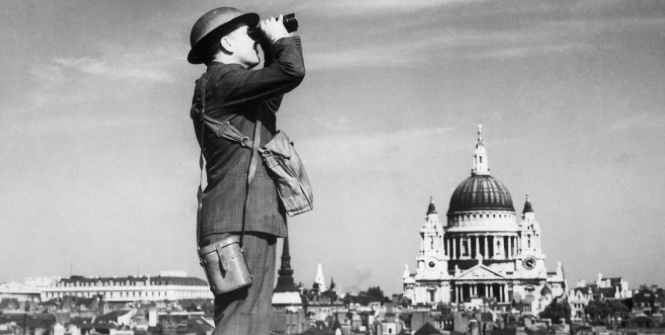Australians and the Battle of Britain

This month marks the start of one of the most brutal and costly air wars in history – the Battle of Britain.
In May 1940 very little stood between Britain and the threat of German invasion. British troops who had been evacuated from Dunkirk were exhausted after fighting in the Battle for France, and much equipment had been lost or was unserviceable. To stop Hitler’s plans to invade Britain, all that was left was the Royal Air Force (RAF), which maintained superiority in the skies over England.
To enable Hitler to mass a flotilla in the English Channel and prepare for a sea-borne invasion of southern England, the battle-hardened German air force, the Luftwaffe, began its aerial assault on the RAF in July 1940. The Luftwaffe possessed nearly twice the number of aircraft and aircrew as the RAF, and its commander, Reichsmarschall Herman Goering, considered the Luftwaffe a vastly superior air force. He believed that his Messerschmitt Bf109 fighters could wipe the RAF from the skies in just four weeks.
Each day between July and October 1940, British and German aircraft clashed in the skies above England. British radar stations and airfields were repeatedly hit by German Stukas, Dorniers, and Heinkels, while British Hurricanes and Spitfires were set upon by large “sweeps” of Messerschmitt fighters. In August 1940, German bombers began striking cities and civilian targets, marking the beginning of what became known as The Blitz.
The turning point in the Battle of Britain came on Sunday 15 September 1940. On that morning, British coastal radar stations picked up dense formations of German bombers and fighter escorts racing across the English Channel. RAF Fighter Command scrambled 24 fighter squadrons to intercept them – the maximum force of 300 Hurricanes and Spitfires that it could muster across southern England. Throughout the day, the skies over Britain were filled with condensation trails as hundreds of British and German aircraft locked in fierce aerial combat.
The RAF suffered heavily throughout the campaign, but on 15 September 1940 the tide turned against the Luftwaffe. Goering’s sudden change of tactics, from striking RAF airfields to bombing British cities, gave Fighter Command the brief respite it needed to reinforce squadrons with aircrew and to replace lost aircraft. Goering’s change of strategy was a fatal error of judgement that gave the RAF the edge it required to deliver the Luftwaffe a fatal blow. Unable to rid the skies of the RAF while faced with mounting losses that could not be replaced, the German invasion was cancelled and the Battle of Britain was won.
15 September 1940 was a day of extremely heavy aerial combat and was chosen as the day on which to remember the significance of the Battle of Britain. Though the ordeal of the Blitz on Britain’s cities continued well into 1941, the pilots and aircrew of the Royal Air Force had forestalled a seaborne invasion of southern England.
The vast majority of men and women who participated in the Battle of Britain were Britons themselves, but members from the other Allied countries made significant contributions to the aerial victory over the Luftwaffe. Pilots from Australia, New Zealand, Canada, India, South Africa, Rhodesia, Jamaica, and the British Mandate of Palestine all flew aerial operations during the battle, as did French, Belgian, and Czechoslovakian aircrew. Volunteers from the United States comprised three Eagle Squadrons attached to Fighter Command, and Poland contributed pilots and aircrew for three whole squadrons. The Hurricane pilots of No. 303 (Kosciuszko) Squadron RAF claimed no less than 126 aerial victories over German aircraft during the three-month campaign. Having lost their own country to the German invaders, Polish pilots were renowned for their daring in fighting for Britain, which they called “last hope island”. A saying at the time went: “If you want a short life and a glorious death, fly with a Polish airman.”
Australia too can be proud that it contributed to the defence of Britain in that crucial summer and autumn, flying operations with Fighter Command, Bomber Command, and Coastal Command. One Australian who flew in Fighter Command during the battle was Flight Lieutenant Pat Hughes of Cooma, New South Wales, who had at least fifteen and half credited kills to his tally and was among the top ten leading aces of the time. Like many of the Australians who flew during the Battle of Britain, Hughes had been a pre-war member of the Royal Australian Air Force, but had transferred to the Royal Air Force under the Short Service Commission Scheme in 1937. He was attached to No. 234 Squadron RAF and flew air cover operations in Spitfires over airfields in Plymouth, and later conducted long distance missions in the Atlantic Ocean and over the Mediterranean Sea. On 15 August 1940, Pat Hughes claimed a double victory of two Messerschmitt Bf110 heavy fighters which earned him the Distinguished Flying Cross. He was killed less than three weeks later, on 7 September 1940, intercepting a large formation of Dornier bombers and their escort of Messerschmitt fighters over Kent.
Thirty-five Australians flew combat operations during the Battle of Britain, of whom ten were killed in action. They were among the airmen immortalised by British Prime Minister Winston Churchill in his powerful tribute to the men of Fighter Command: “Never in the field of human conflict was so much owed by so many to so few.”
Aaron Pegram is a Senior Historian in the Military History Section at the Australian War Memorial. This article was originally published on 15 September 2010 at the Australian War Memorial website. It is republished with permission.


